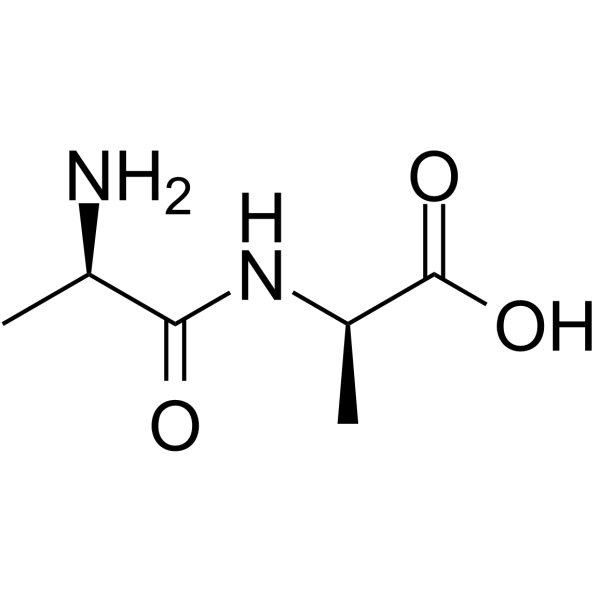H-D-Ala-D-Ala-OH

H-D-Ala-D-Ala-OH structure
|
Common Name | H-D-Ala-D-Ala-OH | ||
|---|---|---|---|---|
| CAS Number | 923-16-0 | Molecular Weight | 160.17100 | |
| Density | 1.208 g/cm3 | Boiling Point | 402.6ºC at 760 mmHg | |
| Molecular Formula | C6H12N2O3 | Melting Point | 286 - 288ºC | |
| MSDS | Chinese USA | Flash Point | 197.3ºC | |
|
Metabolomic profiles delineate potential role for sarcosine in prostate cancer progression.
Nature 457(7231) , 910-4, (2009) Multiple, complex molecular events characterize cancer development and progression. Deciphering the molecular networks that distinguish organ-confined disease from metastatic disease may lead to the identification of critical biomarkers for cancer invasion an... |
|
|
Relationship between glycopeptide production and resistance in the actinomycete Nonomuraea sp. ATCC 39727.
Antimicrob. Agents Chemother. 58(9) , 5191-201, (2014) Glycopeptides and β-lactams inhibit bacterial peptidoglycan synthesis in Gram-positive bacteria; resistance to these antibiotics is studied intensively in enterococci and staphylococci because of their relevance to infectious disease. Much less is known about... |
|
|
Bond dissociation of the dipeptide dialanine and its derivative alanine anhydride induced by low energy electrons.
J. Chem. Phys. 134(5) , 054305, (2011) Dissociative electron attachment to dialanine and alanine anhydride has been studied in the gas phase utilizing a double focusing two sector field mass spectrometer. We show that low-energy electrons (i.e., electrons with kinetic energies from near zero up to... |
|
|
Experimental strategies for functional annotation and metabolism discovery: targeted screening of solute binding proteins and unbiased panning of metabolomes.
Biochemistry 54(3) , 909-31, (2015) The rate at which genome sequencing data is accruing demands enhanced methods for functional annotation and metabolism discovery. Solute binding proteins (SBPs) facilitate the transport of the first reactant in a metabolic pathway, thereby constraining the re... |
|
|
Infrared spectroscopy of the alanine dipeptide analog in liquid water with DFT-MD. Direct evidence for P(II)/beta conformations.
Phys. Chem. Chem. Phys. 12 , 10198-10209, (2010) Following our previous work [J. Phys. Chem. B. Lett., 2009, 113, 10059], DFT-based molecular dynamics (DFTMD) simulations of 2-Ala peptide (i.e. Ac-Ala-NHMe dialanine peptide analog with methyl group caps at the extremities) immersed in liquid water at room t... |
|
|
Atomic multipoles: electrostatic potential fit, local reference axis systems, and conformational dependence.
J. Comput. Chem. 33(20) , 1673-88, (2012) Currently, all standard force fields for biomolecular simulations use point charges to model intermolecular electrostatic interactions. This is a fast and simple approach but has deficiencies when the electrostatic potential (ESP) is compared to that from ab ... |
|
|
Kinetic mechanism and inhibition of Mycobacterium tuberculosis D-alanine:D-alanine ligase by the antibiotic D-cycloserine.
FEBS J. 280(4) , 1150-66, (2013) D-cycloserine (DCS) is an antibiotic that is currently used in second-line treatment of tuberculosis. DCS is a structural analogue of D-alanine, and targets two enzymes involved in the cytosolic stages of peptidoglycan synthesis: alanine racemase (Alr) and D-... |
|
|
Selenium and selenomethionine levels in prostate cancer patients.
Cancer Detect. Prev. 28(1) , 8-16, (2004) Selenium (Se) and selenomethionine (Se-Met) have been identified as potential chemopreventive agents of prostate cancer. Using an assay for the speciation (separation and identification) and quantification of selenoamino acids, Se-Met was profiled in serum an... |
|
|
Urinary unconjugated 5 alpha-androstane-3 alpha, 17 beta-diol in patients with prostatic tumours.
Urol. Res. 10(2) , 81-4, (1982) A sensitive and reliable radioimmunoassay (RIA) for urinary unconjugated 5 alpha-androstane-3 alpha, 17 beta-diol is described. The mean overall recovery of unconjugated 5 alpha-androstane-3 alpha, 17 beta-diol was found to be 57.4%. The sensitivity of the as... |
|
|
Plasma carotenoids, retinol, and tocopherols and the risk of prostate cancer in the European Prospective Investigation into Cancer and Nutrition study.
Am. J. Clin. Nutr. 86(3) , 672-81, (2007) Previous studies suggest that high plasma concentrations of carotenoids, retinol, or tocopherols may reduce the risk of prostate cancer.We aimed to examine the associations between plasma concentrations of 7 carotenoids, retinol, alpha-tocopherol, and gamma-t... |